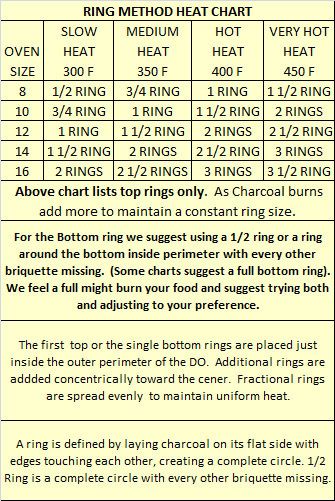The cooking science of the heat.
Are you looking for a method to estimate the amount of hot coals when Dutch Oven Cooking? Here are some things to know and a couple common methods. Someone told me not too long ago they had an app on their phone with a charcoal calculator. But since we are cooking the old fashion way, lets use our old fashion brain to remember how to get our heat right. I personally use the 3 Uppy-down rule. Easily to remember and nothing to carry. The same rule applies to all diameters of Dutch Ovens.
If you can successfully bake a recipe in your kitchen oven, there is no reason you cannot produce similar results using a Dutch Oven, and hot coals.
There is some science to using coals. You have to be aware of some of the issues to get consistent heat.
Consistent heat can be generated from modern Charcoal. Whether you cook in competition (which I do) or just want to master your skills preparing family meals. Be aware temperatures and cooking time can even vary between brands. My “go to” preferred brand is Kingsford. Campfire coals are a different animal and I am not discussing them. Other than to touch on the fact they are a usable source of heat if you care to master another technique.
Some cooks prefer campfire generated wood coals. Campfire type coals will generate different heat, and cook duration times, depending on the species and dryness of the wood used. The best of cooks have used the good old “trial and error method” to hone their skill. This is what makes Dutch Oven cooking so much fun.
My suggestion for new Cast Iron Cooks, is to select your choice/brand of charcoal briquettes. Then stick with your selection until you are cooking with consistent results similar to what you obtain using your kitchen gas or electric oven. Once you get the hang of it, start experimenting with other brands, or campfire coals and various species of wood.
There are other methods and techniques not covered in this article. Many have their own special way of getting the heat right. There are many seasoned cooks out there cooking over fire….and just as many methods of doing it. So we will list a couple to get you started in this great past time of Dutch Oven cooking. Search for more, or join a cooking group to see how its done…then use your favorite method.
If you are new to DO cooking, or haven’t yet gotten consistent baking results, we recommend sticking with one source of fuel until you understand your heat and your recipe(s). As we mentioned, we have had the best results with Kingsford brand charcoal. It normally is ready to go 15 minutes after starting, and generally gives you about 45-60 minutes worth of cook time. A great choice to start with before you venture on to other experimentation. I personally still use this brand at home and during competition cook-offs. Plus it is often the provided brand at cook-offs where charcoal is supplied. This is not a paid endorsement, but a personal preference and recommendation.
Other factors such as wind, altitude, and surrounding air temperature, affect your heat and cook time. In this article we are only going to provide a couple general “rule of thumb” methods to obtain your heat. This is under no wind (or using a wind screen to block the wind), and during comfortable air temperature such as spring, summer, and fall.
Now to some of the science.
In all coal counting, or coal placement methods, the first rule to remember is more hot coals must be on top and less hot coals must be on the bottom. Heat naturally rises, so more of the bottom heat transfers and is absorbed into the bottom of the DO. The heat needed on the top must radiate down, which requires more coals to produce the same top temperature within the oven. It is not natural for heat to go down. Since it is natural for the top coals heat to just rise, more of the top heat is lost. So remember, More coals on top and less on the bottom!
One of the most common errors of a new Dutch Oven cook is to place too many coals underneath the DO. The result is food burned onto the bottom. It is the quickest way to wreak an otherwise perfect recipe.
The second rule to remember in all methods is, the coals need arranged toward the outer perimeter of both the bottom, as well as the lid to avoid burning.
Thirdly rotate your DO, and DO lid, at various times during the cooking process. This simple technique helps prevent hot spots forming and burning food. Every 15 minutes rotate the lid and bottom 90° in opposite directions.
Cakes are tricky since they might “fall” if the pot is bumped too hard. Dump cakes and cobblers are usually pretty ‘wet’ and normally will not need rotated, thus preventing falling. Rotate very carefully if you do start rotating cakes. It is best to bake with other techniques to avoid rotating cakes. There are other advanced techniques such as raising pans inside a DO, using an internal trivet. But that is a whole different subject.

3 UPPY DOWN Heat Rule Method
The simplest rule and easiest to remember. That we have heard of. Uses the “3 Uppy Down Rule”. This is our preferred method. Once you use it a few times, and get it in your head, you won’t have to carry any type of chart. In general it produces 350° in any Diameter size Dutch Oven. As the title of the rule implies, and knowing you need more heat on top than on the bottom, you have the 3 to remember for any pot. The only other factor is, knowing the Diameter of your pot. If you have a normal depth 12 inch DO, you simply add 3 to the diameter for the top (12+3=15 coals). You then minus 3 from the diameter for the bottom (12-3=9 Coals).
So for another example, if you have a 10 inch DO and needing 350°. TOP coals (10+3=13). Bottom coals (10-3=7)
Rule of thumb for additional heat is; each additional coal added to the top only, will increase the internal temperature an additional 10 to 20 degrees. Round that off to 15 for rule of thumb.
350° Heat
Size Dutch Oven Top Coals Bottom Coals
9 inch 9+3=12 9-3=6
10 inch 10+3=13 10-3=7
12 inch 12+3=15 12-3=9
14 inch 14+3=17 14-3=11
16 inch 16+3=19 16-3=13
*This is method produces 350° heat. Each Additional coal on top raises the internal temperature 10 to 20°
*Deep Dutch Ovens may need an additional coal or 2 on top to get to the 350° mark (add it to the top)
*Wind, air temperature, and altitude may affect temperature and cook times
*Recipes that need to cook/bake more than an hour need a new batch of coals started at the 45 minute cook mark, then added after the first 55 to 60 minutes of cooking has ended. Re-apply as needed.
Below is a second method. Preferred by many, More complicated than we like. But if you try this one and like it, print or re-create this chart. Then carry it with your recipes or Dutch Oven Cookbook.
Ring Method Heat Chart Method
![]()



